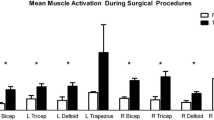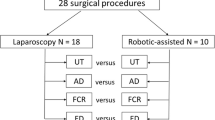Abstract
Introduction
Work related injuries in minimally invasive surgery (MIS) are common because of the strains placed on the surgeon’s or assistant’s body. The objective of this study was to compare specific ergonomic risks among surgeons and surgical trainees performing robotic and laparoscopic procedures.
Materials and methods
Ergonomic data and discomfort questionnaires were recorded from surgeons and trainees (fellows/residents) for both robotic and laparoscopic procedures. Perceived discomfort questionnaires were recorded pre/postoperatively. Intraoperatively, biomechanical loads were captured using motion tracking sensors and electromyography (EMG) sensors. Perceived discomfort, body position and muscle activity were compared between robotic and laparoscopic procedures using a linear regression model.
Results
Twenty surgeons and surgical trainees performed 29 robotic and 48 laparoscopic procedures. Postoperatively, increases in right finger numbness and right shoulder stiffness and surgeon irritability were noted after laparoscopy and increased back stiffness after robotic surgery. Further, the laparoscopic group saw increases in right hand/shoulder pain (OR 0.8; p = 0.032) and left hand/shoulder pain (0.22; p < 0.001) compared to robotic. Right deltoid and trapezius excessive muscle activity were significantly higher in laparoscopic operations compared to robotic. Demanding and static positioning was similar between the two groups except there was significantly more static neck position required for robotic operations.
Conclusion
Robotic assisted surgeries led to lower postoperative discomfort and muscle strain in both upper extremities, particularly dominant side of the surgeon, but increased static neck positioning with subjective back stiffness compared with laparoscopy. These recognized ergonomic differences between the two platforms can be used to raise surgeon awareness of their intraoperative posture and to develop targeted physical and occupational therapy interventions to decrease surgeon WMSDs and increase surgeon longevity.

Similar content being viewed by others
References
Cuschieri A (1992) The spectrum of laparoscopic surgery. World J Surg 16:1089–1097
Fitch K, Engel T, Bochner A (2015) Cost differences between open and minimally invasive surgery. Manag Care 24:40–48
Berguer R, Forkey D, Smith W (1999) Ergonomic problems associated with laparoscopic surgery. Surg Endosc 13:466–468
Esposito C, El Ghoneimi A, Yamataka A, Rothenberg S, Bailez M, Ferro M, Gamba P, Castagnetti M, Mattioli G, Delagausie P (2013) Work-related upper limb musculoskeletal disorders in paediatric laparoscopic surgery. A multicenter survey. J Pediatr Surg 48:1750–1756
Franasiak J, Ko EM, Kidd J, Secord AA, Bell M, Boggess JF, Gehrig PA (2012) Physical strain and urgent need for ergonomic training among gynecologic oncologists who perform minimally invasive surgery. Gynecol Oncol 126:437–442
Gofrit ON, Mikahail AA, Zorn KC, Zagaja GP, Steinberg GD, Shalhav AL (2008) Surgeons’ perceptions and injuries during and after urologic laparoscopic surgery. Urology 71:404–407
Park A, Lee G, Seagull FJ, Meenaghan N, Dexter D (2010) Patients benefit while surgeons suffer: an impending epidemic. J Am Coll Surg 210:306–313
Sari V, Nieboer TE, Vierhout ME, Stegeman DF, Kluivers KB (2010) The operation room as a hostile environment for surgeons: physical complaints during and after laparoscopy. Minim Invasive Ther Allied Technol 19:105–109
Wauben L, Van Veelen M, Gossot D, Goossens R (2006) Application of ergonomic guidelines during minimally invasive surgery: a questionnaire survey of 284 surgeons. Surg Endosc 20:1268–1274
Lanfranco AR, Castellanos AE, Desai JP, Meyers WC (2004) Robotic surgery: a current perspective. Ann Surg 239:14
Tan A, Ashrafian H, Scott AJ, Mason SE, Harling L, Athanasiou T, Darzi A (2016) Robotic surgery: disruptive innovation or unfulfilled promise? A systematic review and meta-analysis of the first 30 years. Surg Endosc 30:4330–4352
Catanzarite T, Tan-Kim J, Whitcomb EL, Menefee S (2018) Ergonomics in surgery: a review. Female Pelvic Med Reconstr Surg 24:1–12
Franasiak J, Craven R, Mosaly P, Gehrig PA (2014) Feasibility and acceptance of a robotic surgery ergonomic training program. J Soc Laparoendoscopic Surg 18:e2014.00166
Lee J, Kang SW, Jung JJ, Choi UJ, Yun JH, Nam KH, Soh E-Y, Chung WY (2011) Multicenter study of robotic thyroidectomy: short-term postoperative outcomes and surgeon ergonomic considerations. Ann Surg Oncol 18:2538–2547
Plerhoples TA, Hernandez-Boussard T, Wren SM (2012) The aching surgeon: a survey of physical discomfort and symptoms following open, laparoscopic, and robotic surgery. J Robot Surg 6:65–72
Santos-Carreras L, Hagen M, Gassert R, Bleuler H (2012) Survey on surgical instrument handle design: ergonomics and acceptance. Surgical innovation 19:50–59
Yu D, Dural C, Morrow MM, Yang L, Collins JW, Hallbeck S, Kjellman M, Forsman M (2017) Intraoperative workload in robotic surgery assessed by wearable motion tracking sensors and questionnaires. Surg Endosc 31:877–886
Lee GI, Lee MR, Clanton T, Sutton E, Park AE, Marohn MR (2014) Comparative assessment of physical and cognitive ergonomics associated with robotic and traditional laparoscopic surgeries. Surg Endosc 28:456–465
Marecik SJ, Chaudhry V, Jan A, Pearl RK, Park JJ, Prasad LM (2007) A comparison of robotic, laparoscopic, and hand-sewn intestinal sutured anastomoses performed by residents. Am J Surg 193:349–355
Stefanidis D, Wang F, Korndorffer JR, Dunne JB, Scott DJ (2010) Robotic assistance improves intracorporeal suturing performance and safety in the operating room while decreasing operator workload. Surg Endosc 24:377–382
Berguer R, Smith W (2006) An ergonomic comparison of robotic and laparoscopic technique: the influence of surgeon experience and task complexity. J Surg Res 134:87–92
Athanasiadis DI, Monfared S, Asadi H, Colgate CL, Yu D, Stefanidis D (2021) An analysis of the ergonomic risk of surgical trainees and experienced surgeons during laparoscopic procedures. Surgery 169:496–501
Beurskens AJ, Bültmann U, Kant I, Vercoulen JH, Bleijenberg G, Swaen GM (2000) Fatigue among working people: validity of a questionnaire measure. Occup Environ Med 57:353–357
Asadi H, Monfared S, Athanasiadis DI, Stefanidis D, Yu D (2021) Continuous, integrated sensors for predicting fatigue during non-repetitive work: demonstration of technique in the operating room. Ergonomics 64(9):1160–1173
Garg A, Kapellusch J, Hegmann K, Wertsch J, Merryweather A, Deckow-Schaefer G, Malloy E, Team WHSR (2012) The strain index (SI) and threshold limit value (TLV) for hand activity level (HAL): risk of carpal tunnelsyndrome (CTS) in a prospective cohort. Ergonomics 55:396–414
McAtamney L, Corlett EN (1993) RULA: a survey method for the investigation of work-related upper limb disorders. Appl Ergon 24:91–99
Szeto GPY, Cheng SWK, Poon JTC, Ting ACW, Tsang RCC, Ho P (2012) Surgeons’ static posture and movement repetitions in open and laparoscopic surgery. J Surg Res 172:e19–e31
Berguer R, Rab GT, Abu-Ghaida H, Alarcon A, Chung J (1997) A comparison of surgeons’ posture during laparoscopic and open surgical procedures. Surg Endosc 11:139–142
Uhrich M, Underwood R, Standeven J, Soper N, Engsberg J (2002) Assessment of fatigue, monitor placement, and surgical experience during simulated laparoscopic surgery. Surg Endosc 16:635–639
Lee E, Rafiq A, Merrell R, Ackerman R, Dennerlein J (2005) Ergonomics and human factors in endoscopic surgery: a comparison of manual vs telerobotic simulation systems. Surg Endosc Other Interv Tech 19:1064–1070
Steven Moore J, Garg A (1995) The strain index: a proposed method to analyze jobs for risk of distal upper extremity disorders. Am Ind Hyg Assoc J 56:443–458
Lawson EH, Curet MJ, Sanchez BR, Schuster R, Berguer R (2007) Postural ergonomics during robotic and laparoscopic gastric bypass surgery: a pilot project. J Robot Surg 1:61–67
Armijo PR, Huang C-K, High R, Leon M, Siu K-C, Oleynikov D (2019) Ergonomics of minimally invasive surgery: an analysis of muscle effort and fatigue in the operating room between laparoscopic and robotic surgery. Surg Endosc 33:2323–2331
Zihni AM, Ohu I, Cavallo JA, Cho S, Awad MM (2014) Ergonomic analysis of robot-assisted and traditional laparoscopic procedures. Surg Endosc 28:3379–3384
Milone M, Manigrasso M, Vertaldi S, Velotti N, Aprea G, Maione F, Gennarelli N, De Simone G, De Conno B, Pesce M (2019) Robotic versus laparoscopic approach to treat symptomatic achalasia: systematic review with meta-analysis. Dis Esophagus 32:1–8
Olavarria OA, Bernardi K, Shah SK, Wilson TD, Wei S, Pedroza C, Avritscher EB, Loor MM, Ko TC, Kao LS (2020) Robotic versus laparoscopic ventral hernia repair: multicenter, blinded randomized controlled trial. BMJ 370:m2457
Yu H-y, Hevelone ND, Lipsitz SR, Kowalczyk KJ, Hu JC (2012) Use, costs and comparative effectiveness of robotic assisted, laparoscopic and open urological surgery. J Urol 187:1392–1399
Sheldon GF (2010) Access to care and the surgeon shortage: American Surgical Association Forum. Ann Surg 252:582–590
Author information
Authors and Affiliations
Corresponding author
Ethics declarations
Disclosures
This submission was funded by SAGES. Dr. Monfared, Dr. Umana, Mr. Asadi, and Mr. Colgate have no conflicts of interest or financial ties to disclose. Dr. Athanasiadis has an unrelated CTSI grant. Dr. Hernandez has an unrelated SAGES research grant for a different project and an unrelated CTSI grant. Dr. Yu has an unrelated grant from Intuitive Surgical, Inc. Dr. Stefanidis has unrelated research grants from ExplORer Surgical, Inc, and from Bard.
Additional information
Publisher's Note
Springer Nature remains neutral with regard to jurisdictional claims in published maps and institutional affiliations.
Rights and permissions
About this article
Cite this article
Monfared, S., Athanasiadis, D.I., Umana, L. et al. A comparison of laparoscopic and robotic ergonomic risk. Surg Endosc 36, 8397–8402 (2022). https://doi.org/10.1007/s00464-022-09105-0
Received:
Accepted:
Published:
Issue Date:
DOI: https://doi.org/10.1007/s00464-022-09105-0




